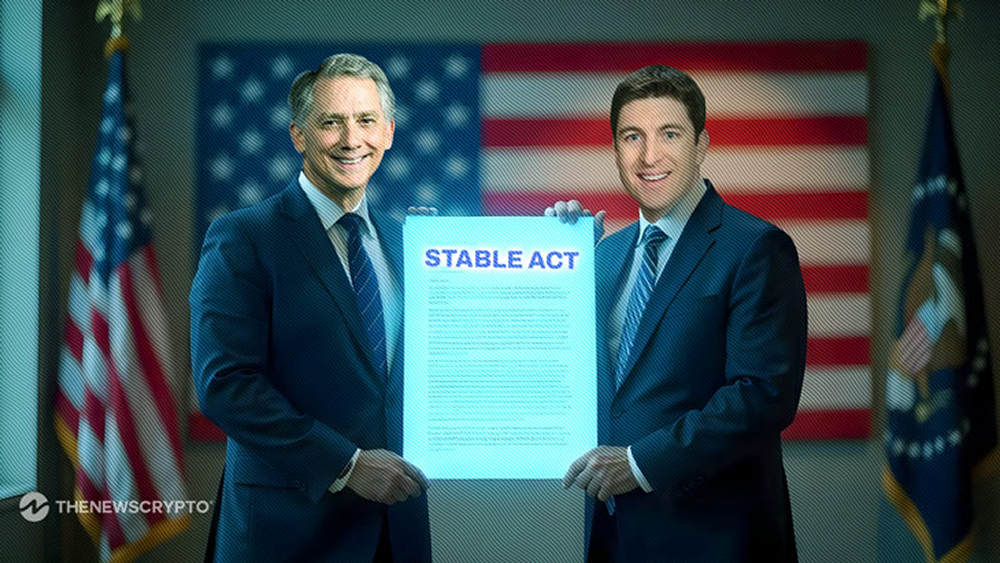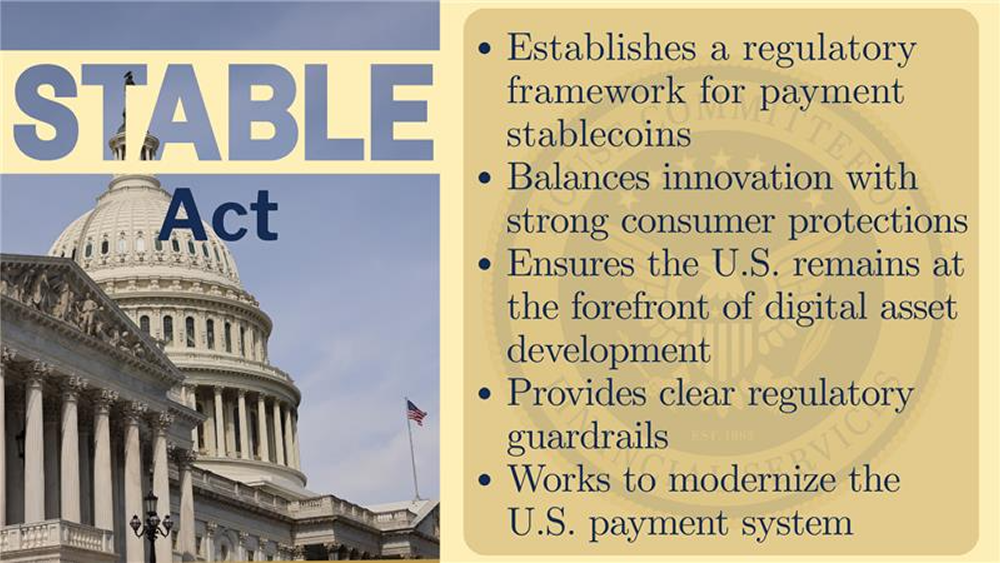On March 26, 2025, the U.S. House Financial Services Committee officially released the full text of the "Stablecoin Transparency and Accountability to Promote Better Ledger Economy Act" (referred to as the "STABLE Act"). This draft was initially proposed by Democratic representatives Rashida Tlaib, Jesús García, and Stephen Lynch in December 2020 but was shelved in the following years. Now, it has resurfaced in a new form and is expected to serve as a cornerstone of the future regulatory framework for stablecoins in the U.S., alongside the Senate's "Guiding and Establishing U.S. Stablecoin National Innovation Act" (referred to as the "GENIUS Act"). This series of actions not only signifies the U.S. commitment to digital financial regulation but also sends a significant signal to the global digital asset industry.
Stablecoins, as the core hub of the digital financial system, can "move the whole body by pulling one hair." From cross-border payments to decentralized finance (DeFi), and as a bridge between traditional finance and blockchain, the influence of stablecoins has long surpassed the realm of cryptocurrencies. Why is the U.S. intensifying its push for stablecoin legislation at this time? Is it attempting to tame this "wild horse," or is it intentionally crafting the U.S. dollar stablecoin as a "weapon" in global financial competition? The introduction of the STABLE Act draft provides us with a window into the U.S. regulatory mindset. This article will delve into the core content of the draft, uncover its underlying logic, and explore its potential impact on the U.S. and global digital asset industry.

STABLE Act Draft: Overview of Core Content
According to the publicly available full text of the STABLE Act draft, the bill aims to establish a clear legal framework for dollar-pegged payment stablecoins, ensuring their transparency, stability, and compliance. Here are the main points of the draft:
- Issuer restrictions and licensing: Only entities approved by federal or state regulatory agencies (such as banks, credit unions, and certain non-bank institutions) can issue stablecoins; unauthorized issuance is illegal, aiming to incorporate traditional financial regulation and curb "wild growth."
- 1:1 full reserve requirement: Issuers must hold high liquidity reserve assets (such as cash or U.S. Treasury bills maturing within 93 days) corresponding to the issuance amount on a 1:1 basis, ensuring redemption capability and preventing Terra/Luna-style risks.
- Prohibition of algorithmic and yield-bearing stablecoins: Stablecoins that maintain value solely through algorithms (like Terra USD) and those that generate yield through staking (like DAI, USDe) are prohibited, emphasizing "stability."
- Transparency and consumer protection: Regular audits and public disclosure of reserve asset composition are required to ensure immediate redemption and compliance with AML/KYC regulations to prevent illegal fund flows.
- Dual-track regulation at state and federal levels: Stablecoins with a market cap below $10 billion will be regulated by states, while those above $10 billion will be directly regulated by the Federal Reserve and OCC, balancing flexibility with systemic risk control.
At the same time, the Senate's GENIUS Act is also being advanced. The two bills are highly aligned in their goals but differ slightly in details. For example, the GENIUS Act places greater emphasis on strengthening the global dominance of the dollar through stablecoin innovation and proposes specific requirements for international regulatory coordination. Both chambers are actively negotiating, and the final version is expected to take shape by mid-2025.

Why is the U.S. Taking Action Now? Analyzing the Underlying Motives
The U.S. has chosen to accelerate stablecoin legislation in 2025, driven by the need for domestic financial stability and strategic positioning in the global competitive landscape.
First, the rapid growth of stablecoins can no longer be ignored. By early 2025, the global stablecoin market had surpassed $200 billion, with dollar-pegged stablecoins dominating. However, the lack of unified regulation has led to accumulating risks. From the collapse of Terra USD to controversies over Tether (USDT) reserve transparency, the potential systemic risks of stablecoins have raised alarms among regulators. The introduction of the STABLE Act clearly aims to delineate clear boundaries in this area, protect consumers, and maintain financial stability.
Second, the global dominance of the dollar is a core consideration driving U.S. legislation. Dollar-pegged stablecoins (like USDT, USDC) are not only the "blood" of the digital economy but also indirectly strengthen the dollar's reserve currency status by increasing demand for U.S. Treasury bonds. In the context of intensifying competition for central bank digital currencies (CBDCs) globally, the U.S. is clearly unwilling to let private stablecoins become chaotic "tokenized dollars," but rather hopes to bring them under control through legislation, transforming "wild horses" into "war horses."
Finally, the pressures of geopolitical and technological competition cannot be overlooked. The European Union's "Markets in Crypto-Assets Regulation" (MiCA) has fully come into effect by the end of 2024, providing a systematic framework for stablecoins; regions like Singapore and Dubai are also actively laying out digital asset regulations. In contrast, if the U.S. continues to remain inactive in the stablecoin space, it risks losing the initiative in technological and financial innovation. The dual approach of the STABLE Act and the GENIUS Act signals the U.S. attempt to catch up.
Impact on the Digital Asset Industry: Challenges and Opportunities
The potential impact of the STABLE Act is profound, as it may reshape the industry landscape while opening new opportunities for Web3 practitioners.
For existing stablecoin issuers, the high compliance standards of the draft will undoubtedly increase operational costs. Companies like Tether, which have long relied on overseas registration, may face higher barriers to entering the U.S. market; while stablecoin projects dependent on algorithms or yield mechanisms will need to undergo complete transformations or even exit the market. A round of industry reshuffling is inevitable, with smaller players likely to exit and larger institutions potentially consolidating their positions.
Conversely, the legalization of stablecoins will significantly enhance their credibility, promoting acceptance in mainstream finance. Banks and payment giants may seize the opportunity to enter the market, issuing compliant stablecoins to compete with traditional credit card networks. More importantly, a clear regulatory framework will attract more institutional capital into the digital asset space, injecting vitality into ecosystems like DeFi and NFTs.
Global Impact: The "Soft Power" Export of Dollar Stablecoins
If the STABLE Act is successfully implemented, U.S.-issued dollar stablecoins are expected to capture a larger share of the global market. This will not only weaken the competitiveness of non-dollar-pegged stablecoins but may also further consolidate the dollar's digital financial hegemony through international regulatory coordination. For Web3 practitioners, this means that greater attention must be paid to compliance dynamics in the U.S. market when planning global strategies.
Conclusion: The "American Moment" in Stablecoin Regulation
The introduction of the STABLE Act draft marks a new phase in U.S. stablecoin regulation. From restricting "lawlessness" to "weaponizing" the dollar, America's intentions are clear. This is not just a regulatory game but a contest among major powers to redefine the rules in the digital economy era. For the digital asset industry, this presents both challenges and opportunities to reshape the future. As Senator Kirsten Gillibrand stated, "The future of stablecoins has strong bipartisan support; it will drive responsible innovation and maintain America's leadership in the digital asset space." The next act of Web3 is gradually unfolding.
This article represents the author's personal views and does not reflect the stance or views of this platform. This article is for informational sharing only and does not constitute any investment advice to anyone.
AiCoin official website: aicoin.com
Telegram: t.me/aicoincn
Twitter: x.com/AiCoinzh
Email: support@aicoin.com
Group chat: Customer Service Yingying、Customer Service KK
免责声明:本文章仅代表作者个人观点,不代表本平台的立场和观点。本文章仅供信息分享,不构成对任何人的任何投资建议。用户与作者之间的任何争议,与本平台无关。如网页中刊载的文章或图片涉及侵权,请提供相关的权利证明和身份证明发送邮件到support@aicoin.com,本平台相关工作人员将会进行核查。




